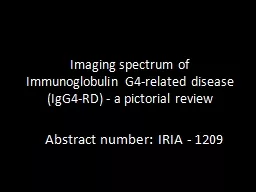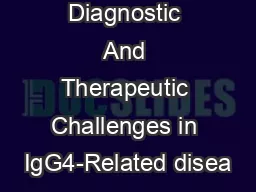PPT-IgG4-related Disease of
Author : SunnySailor | Published Date : 2022-08-01
the Genitourinary System Spectrum of Imaging Findings and ClinicalPathologic Features Department of Radiology 1 SEOUL ST MARYS HOSPITAL and 2 Eunpyeong ST Marys
Presentation Embed Code
Download Presentation
Download Presentation The PPT/PDF document "IgG4-related Disease of" is the property of its rightful owner. Permission is granted to download and print the materials on this website for personal, non-commercial use only, and to display it on your personal computer provided you do not modify the materials and that you retain all copyright notices contained in the materials. By downloading content from our website, you accept the terms of this agreement.
IgG4-related Disease of: Transcript
Download Rules Of Document
"IgG4-related Disease of"The content belongs to its owner. You may download and print it for personal use, without modification, and keep all copyright notices. By downloading, you agree to these terms.
Related Documents














